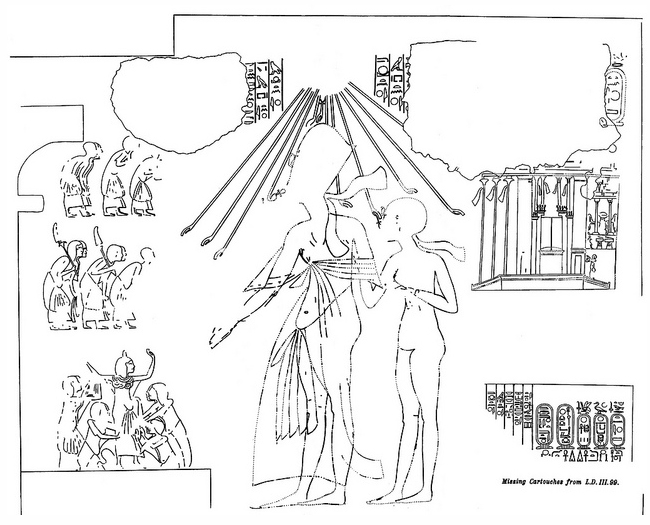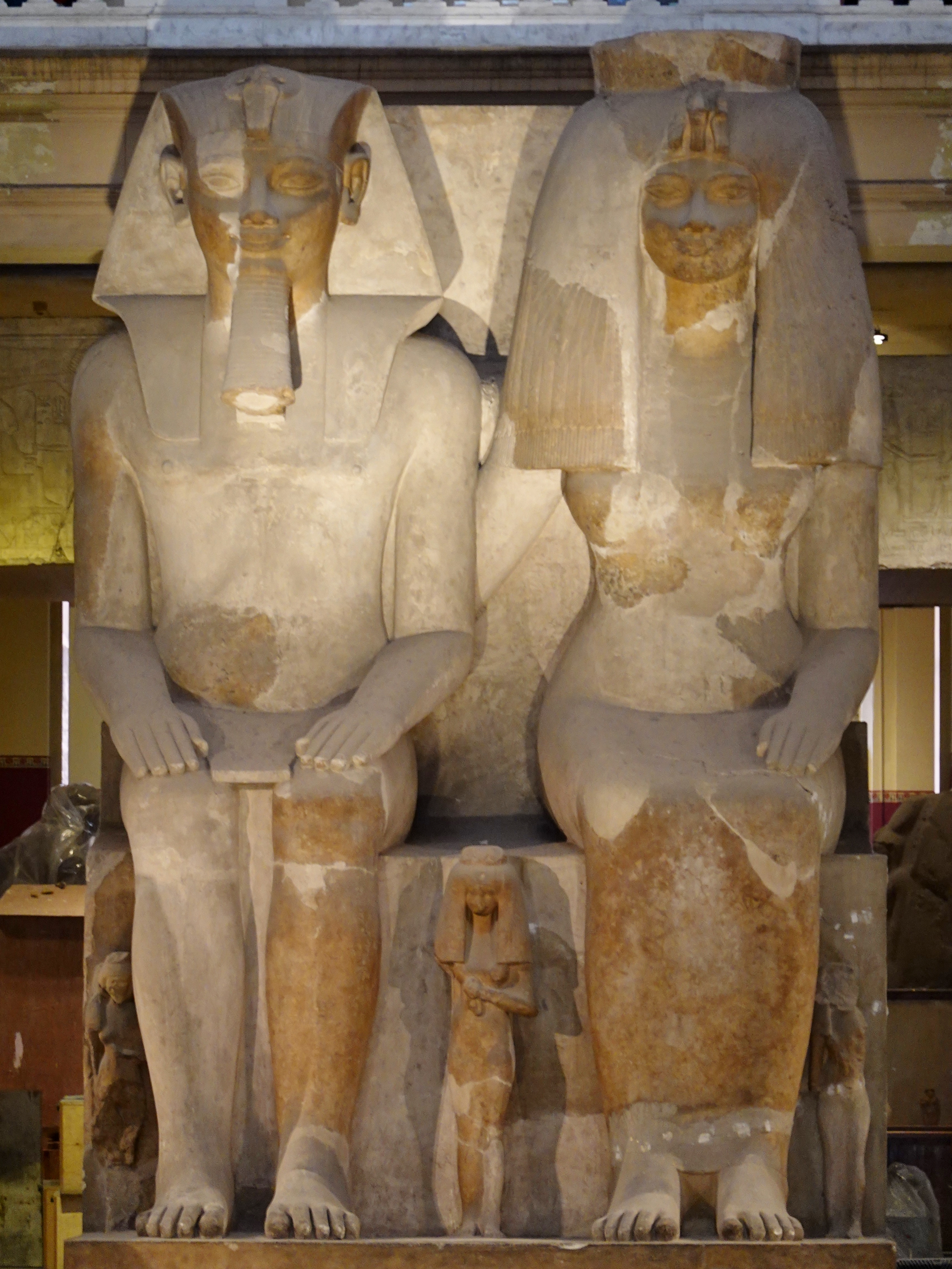|
Meritaten Tasherit
Meritaten Tasherit, which means ''Meritaten the Younger'' was an ancient Egyptian princess of the 18th Dynasty. She is likely to have been the daughter of Meritaten, eldest daughter of Pharaoh Akhenaten. Who her father was remains a matter of debate. Many assume it to be Meritaten's father, Akhenaten, or possibly her husband Smenkhkare. Since both Meritaten Tasherit and another princess, Ankhesenpaaten Tasherit appear only in texts that once mentioned Akhenaten's second wife Kiya, it is also possible that they were children of Akhenaten and Kiya, or that they were fictional, replacing the name of Kiya's daughter, who might have been Beketaten, more commonly thought to be Tiye's child. Meritaten Tasherit's fate is uncertain. The mention of the god Aten in her name suggests that she was indeed a daughter of Akhenaten, since his successors reverted his religious reforms, and reverted to the worship of Egypt Egypt ( ar, مصر , ), officially the Arab Republic of Egypt, is a ... [...More Info...] [...Related Items...] OR: [Wikipedia] [Google] [Baidu] |
Meritaten
Meritaten, also spelled Merytaten, Meritaton or Meryetaten ( egy, mrii.t-itn) (14th century BC), was an ancient Egyptian royal woman of the Eighteenth Dynasty of Egypt. Her name means "She who is beloved of Aten"; Aten being the sun-deity whom her father, Pharaoh Akhenaten, worshipped. She held several titles, performing official roles for her father and becoming the Great Royal Wife to Pharaoh Smenkhkare, who may have been a brother or son of Akhenaten. Meritaten also may have served as pharaoh in her own right under the name Ankhkheperure Neferneferuaten.J. Tyldesley, ''Chronicle of the Queens of Egypt'', 2006, Thames & Hudson, pg 136–137 Family Meritaten was the first of six daughters born to Pharaoh Akhenaten and his Great Royal Wife, Nefertiti. Her sisters are Meketaten, Ankhesenpaaten, Neferneferuaten Tasherit, Neferneferure, and Setepenre. Meritaten is mentioned in diplomatic letters, by the name ''Mayati''. She is mentioned in a letter from Abimilki of Tyre. The refe ... [...More Info...] [...Related Items...] OR: [Wikipedia] [Google] [Baidu] |
Akhenaten
Akhenaten (pronounced ), also spelled Echnaton, Akhenaton, ( egy, ꜣḫ-n-jtn ''ʾŪḫə-nə-yātəy'', , meaning "Effective for the Aten"), was an ancient Egyptian pharaoh reigning or 1351–1334 BC, the tenth ruler of the Eighteenth Dynasty. Before the fifth year of his reign, he was known as Amenhotep IV ( egy, jmn-ḥtp, links=no, meaning " Amun is satisfied", Hellenized as ''Amenophis IV''). As a pharaoh, Akhenaten is noted for abandoning Egypt's traditional polytheism and introducing Atenism, or worship centered around Aten. The views of Egyptologists differ as to whether the religious policy was absolutely monotheistic, or whether it was monolatry, syncretistic, or henotheistic. This culture shift away from traditional religion was reversed after his death. Akhenaten's monuments were dismantled and hidden, his statues were destroyed, and his name excluded from lists of rulers compiled by later pharaohs. Traditional religious practice was gradually restor ... [...More Info...] [...Related Items...] OR: [Wikipedia] [Google] [Baidu] |
Smenkhkare
Smenkhkare (alternatively romanized ''Smenkhare'', ''Smenkare,'' or ''Smenkhkara''; meaning "'Vigorous is the Soul of Re") was an ancient Egyptian pharaoh of unknown background who lived and ruled during the Amarna Period of the 18th Dynasty. Smenkhkare was husband to Meritaten, the daughter of his likely co-regent, Akhenaten. Very little is known of Smenkhkare for certain because later kings sought to erase the Amarna Period from history. Because of this, perhaps no one from the Amarna Interlude has been the subject of so much speculation as Smenkhkare. Origin and family Smenkhkare's origins are unknown. It is assumed he was a member of the royal family, likely either a brother or son of the pharaoh Akhenaten. If he is Akhenaten's brother, his mother was likely either Tiye or Sitamun. If a son of Akhenaten, he was presumably an older brother of Tutankhamun, as he succeeded the throne ahead of him; his mother was likely an unknown, lesser wife. An alternative suggestion, based ... [...More Info...] [...Related Items...] OR: [Wikipedia] [Google] [Baidu] |
Ankhesenpaaten Tasherit
Ankhesenpaaten Tasherit (or Ankhesenpaaten-ta-sherit, “Ankhesenpaaten the Younger”) was an ancient Egyptian princess of the 18th Dynasty. Ankhesenpaaten Tasherit and another princess, Meritaten Tasherit are two princesses who appear in scenes dating to the later part of the reign of Akhenaten. The titles of at least one of the princess is of the form " ..-taherit, born of .. born of the King's Great Wife .. The inscription is damaged and the name of the mother and grandmother of the princesses has not been preserved.Dodson, Aidan, Amarna Sunset: Nefertiti, Tutankhamun, Ay, Horemheb, and the Egyptian Counter-Reformation. The American University in Cairo Press. 2009, Tyldesley, Joyce. Nefertiti: Egypt's Sun Queen. Penguin. 1998. , pp 168, 173 Ankhesenpaaten Tasherit has been known to archaeologists since 1938, when a talatat block with her picture and name was found in Hermopolis. Proposed parents Several different sets of parents have been proposed for Ankhesenpaaten Tasher ... [...More Info...] [...Related Items...] OR: [Wikipedia] [Google] [Baidu] |
Kiya
Kiya was one of the wives of the Egyptian Pharaoh Akhenaten. Little is known about her, and her actions and roles are poorly documented in the historical record, in contrast to those of Akhenaten's ‘Great royal wife’, Nefertiti. Her unusual name suggests that she may originally have been a Mitanni princess.Reeves, C. Nicholas. ''New Light on Kiya from Texts in the British Museum'', p.100 The Journal of Egyptian Archaeology, Vol. 74 (1988) Surviving evidence demonstrates that Kiya was an important figure at Akhenaten's court during the middle years of his reign, when she had a daughter with him.William J. Murnane. ''Texts from the Amarna Period in Egypt.'' Edited by E.S. Meltzer. Atlanta: Society of Biblical Literature, 1995. () Page 9, pp 90–93, pp 210–211.Aidan Dodson. Amarna Sunset: Nefertiti, Tutankhamun, Ay, Horemheb, and the Egyptian Counter Reformation. The American University in Cairo Press, 2009. () Page 17. She disappears from history a few years before her royal h ... [...More Info...] [...Related Items...] OR: [Wikipedia] [Google] [Baidu] |
Beketaten
Beketaten ( egy, bꜣk.t-itn)(14th century BCE) was an ancient Egyptian princess of the 18th Dynasty. Beketaten is considered to be the youngest daughter of Pharaoh Amenhotep III and his Great Royal Wife Tiye, thus the sister of Pharaoh Akhenaten.Aidan Dodson & Dyan Hilton, The Complete Royal Families of Ancient Egypt, Thames & Hudson (2004), p.154 Her name means "Handmaid of Aten". Family Beketaten was most likely the youngest daughter of Amenhotep III and Tiye. This would mean their other children were her siblings, including Prince Thutmose, the Pharaoh Akhenaten, Sitamun, Isis, Henuttaneb, and Nebetah. Some scholars have speculated that Nebetah was identical with Beketaten. However, no evidence proves that they are the same person. It has also been suggested that she might be the daughter of Akhenaten and his secondary wife, Kiya. Kiya is shown on a few occasions with a princess whose name ends in -''aten''. However, the full name of the princess has been lost. It ha ... [...More Info...] [...Related Items...] OR: [Wikipedia] [Google] [Baidu] |
Tiye
Tiye (c. 1398 BC – 1338 BC, also spelled Tye, Taia, Tiy and Tiyi) was the daughter of Yuya and Thuya. She became the Great Royal Wife of the Egyptian pharaoh Amenhotep III. She was the mother of Akhenaten and grandmother of Tutankhamun. In 2010, DNA analysis confirmed her as the mummy known as "The Elder Lady" found in the tomb of Amenhotep II ( KV35) in 1898. Family and early life Tiye's father, Yuya, was a non-royal, wealthy landowner from the Upper Egyptian town of Akhmim, where he served as a priest and superintendent of oxen or commander of the chariotry. Tiye's mother, Thuya, was involved in many religious cults, as her different titles attested (''Singer of Hathor'', ''Chief of the Entertainers'' of both Amun and Min...), which suggests that she was a member of the royal family. Egyptologists have suggested that Tiye's father, Yuya, was of foreign origin due to the features of his mummy and the many different spellings of his name, which might imply it was a non- ... [...More Info...] [...Related Items...] OR: [Wikipedia] [Google] [Baidu] |
Aten
Aten also Aton, Atonu, or Itn ( egy, jtn, ''reconstructed'' ) was the focus of Atenism, the religious system established in ancient Egypt by the Eighteenth Dynasty pharaoh Akhenaten. The Aten was the disc of the sun and originally an aspect of Ra, the sun god in traditional ancient Egyptian religion. Akhenaten, however, made it the sole focus of official worship during his reign. In his poem " Great Hymn to the Aten", Akhenaten praises Aten as the creator, giver of life, and nurturing spirit of the world. Aten does not have a creation myth or family but is mentioned in the ''Book of the Dead''. The worship of Aten was initially dismantled by Tutankhamun and later eradicated by Tutankhamun's former military general Horemheb. Etymology and origin The word ''Aten'' appears in the Old Kingdom as a noun meaning "disc" which referred to anything flat and circular; the sun was called the "disc of the day" where Ra was thought to reside. By analogy, the term "silver aten" was s ... [...More Info...] [...Related Items...] OR: [Wikipedia] [Google] [Baidu] |
Egypt
Egypt ( ar, مصر , ), officially the Arab Republic of Egypt, is a transcontinental country spanning the northeast corner of Africa and southwest corner of Asia via a land bridge formed by the Sinai Peninsula. It is bordered by the Mediterranean Sea to the north, the Gaza Strip of Palestine and Israel to the northeast, the Red Sea to the east, Sudan to the south, and Libya to the west. The Gulf of Aqaba in the northeast separates Egypt from Jordan and Saudi Arabia. Cairo is the capital and largest city of Egypt, while Alexandria, the second-largest city, is an important industrial and tourist hub at the Mediterranean coast. At approximately 100 million inhabitants, Egypt is the 14th-most populated country in the world. Egypt has one of the longest histories of any country, tracing its heritage along the Nile Delta back to the 6th–4th millennia BCE. Considered a cradle of civilisation, Ancient Egypt saw some of the earliest developments of writing, agriculture ... [...More Info...] [...Related Items...] OR: [Wikipedia] [Google] [Baidu] |
14th-century BC Egyptian Women
As a means of recording the passage of time, the 14th century was a century lasting from 1 January 1301 ( MCCCI), to 31 December 1400 ( MCD). It is estimated that the century witnessed the death of more than 45 million lives from political and natural disasters in both Europe and the Mongol Empire. West Africa experienced economic growth and prosperity. In Europe, the Black Death claimed 25 million lives wiping out one third of the European population while the Kingdom of England and the Kingdom of France fought in the protracted Hundred Years' War after the death of Charles IV, King of France led to a claim to the French throne by Edward III, King of England. This period is considered the height of chivalry and marks the beginning of strong separate identities for both England and France as well as the foundation of the Italian Renaissance and Ottoman Empire. In Asia, Tamerlane (Timur), established the Timurid Empire, history's third largest empire to have been ever esta ... [...More Info...] [...Related Items...] OR: [Wikipedia] [Google] [Baidu] |




